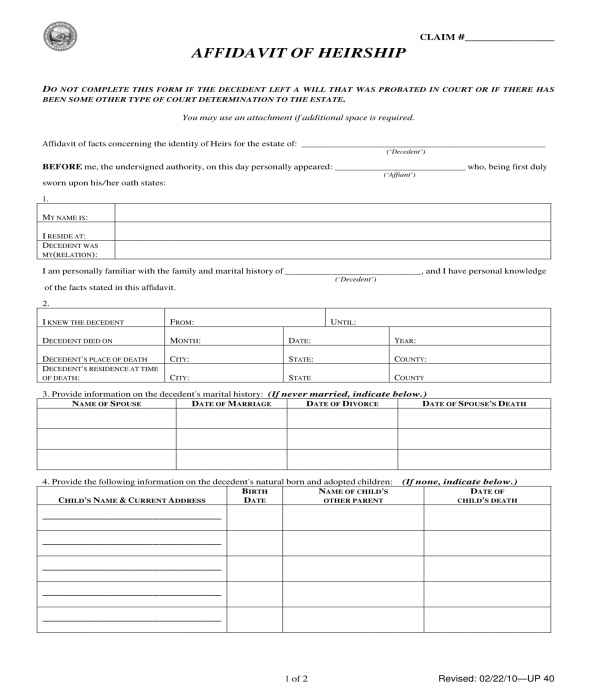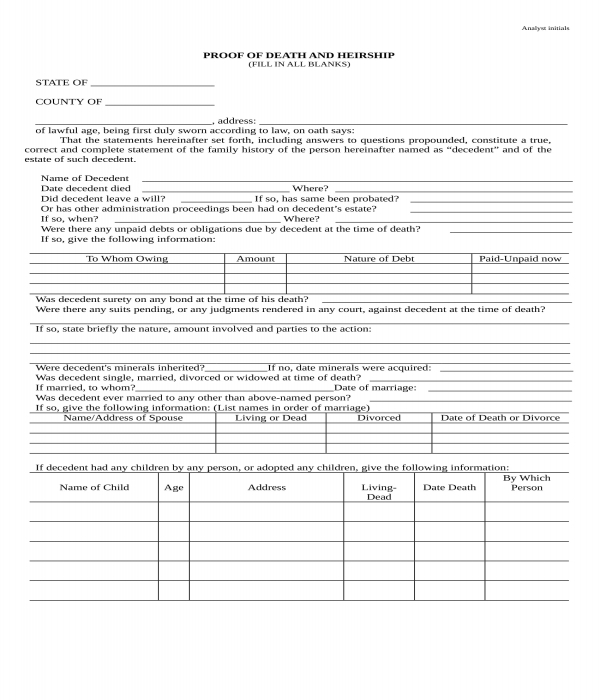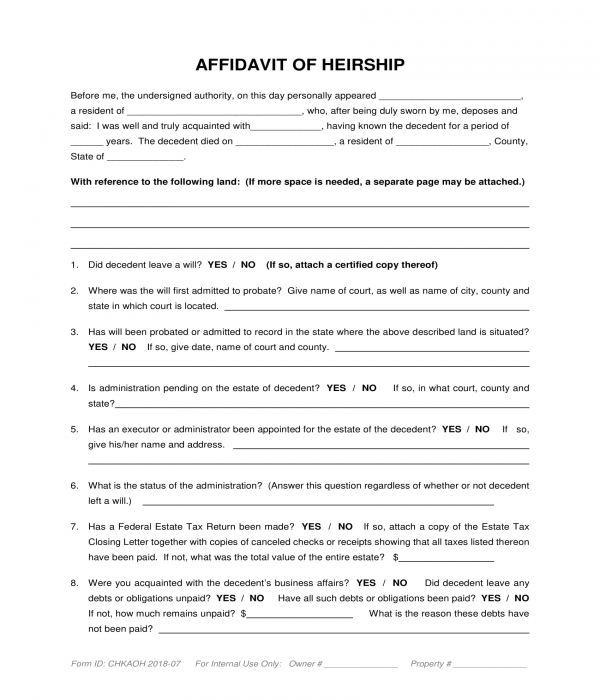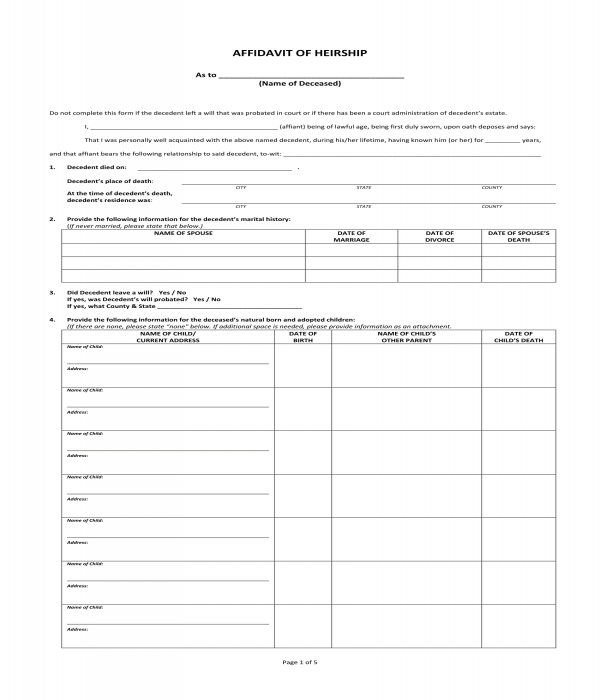An affidavit of heirship form is a document which is required to be submitted by an individual who wants to claim a property of a deceased relative. However, the form is only suitable and applicable to be used by affiants whose deceased relative left not a single will or testament or any statement indicating where his properties will be given after his death. Also, the form is often used for fulfilling a property claim without having the need to head to the probate court. Regardless of the reason and purpose of the affiant, an affidavit of heirship form must be supplied and submitted with other documents to prove the relationship of the affiant with the deceased property owner and to prove the deceased’ identity and status.
Affidavit of Heirship Form
Significant Contents in an Affidavit of Heirship Form
Affidavit of heirship forms can have several sections and contents which are needed to be fulfilled by the affiant for him to begin processing his claim to the property and rights owned by his deceased relative. One of the most significant content in an affidavit of heirship form is the decedent’s information. It is important to have all the particulars of the decedent including, but not limited to, his death data and his personal information. The next most significant content is the identity of the other heir, or the affiant. All the disclosed data of the affiant will be used by the State’s authority for determining and for verifiying the legitimacy of his claims as well as for acknowledging other possible heirs to the decedent’s properties. Along with the affiant’s details would be the identities of the decedent’s grandchildren, parents, and even his nephews and niece which are directly related to him.
Lastly, a certification statement must be signed by the affiant which is for indicating that the affiant is true and honest to what he is disclosing in the form and that he is a relative of the decedent, or a rightful heir to his properties. In order to legalize the certification of the affiant, a notary public who is licensed and knowledgeable about the affiant’s case must also sign the form, affix his notary seal, and state the date of when his commission will expire.
Affidavit of Heirship Form in DOC
How to Fill out an Affidavit of Heirship Form
There are approximately eight sections in a basic or general affidavit of heirship form. All of these sections are intended to be filled out by the applicant or the heir of the decedent. To fill out the form, the steps below can be followed or be used as a guide by any applicant in order for him to complete the affidavit form and begin the process of claiming his rights in the property left by the decedent:
Step 1: Read all the instructions on the form and determine what information needs to be supplied. By reading or scanning throughout the document, the applicant will be able to know what other legal forms or accompanying paperwork he must have on-hand for him to fill out the fields in each section. This includes the decedent’s certificate of death as well as some of the identification cards of the other children or heirs of the decedent. Moreover, the instructions will also be beneficial in informing the applicant of the eligibility requirements that he must meet including the lack of the decedent’s last will and testament or other supporting documents.
Step 2: State the name of the decedent and the affiant or the applicant. Since the document to be completed is an affidavit form, the applicant is known or called as the “affiant” or the person who is filing the affidavit to the State. In the first section of the form, the affiant or the applicant will have to state the full legal name of the decedent along with his own name on the affidavit statement.
Step 3: Complete the affiant general information. This section will be for the name, address, and the relationship of the affiant to the decedent. Most affidavit forms will have this section in a table format which will then be followed by another type of statement indicating the knowledge of the affiant for the facts in relation to the decedent and the decedent’s family history.
Step 4: Fill in the decedent information section. The period or year when the affiant knew the decedent will be stated in this section along with other pieces of general information such as the decedent’s date of death, place of death, residential address, and time of death. All of these data can be obtained by the affiant from the decedent’s death certificate or the medical report of the medical institution where the decedent was sent prior to his death.
Step 5: Disclose the decedent’s marital history. The names of the decedent’s former spouses should be enlisted in this section of the form with the individual dates of marriages, divorce, and dates of when each spouse’s death. In the event that the decedent was not legally married, then the affiant must indicate in the section or in the form that the decedent died single, or have been cohabitating with an individual, or other situations relating to the decedent’s marital status.
Affidavit of Heirship Questionnaire Form
Step 6: Enlist the names of the heirs or the decedent’s children. Each of the heir’s names and their personal information such as their individual dates of birth, the name of their other parents, and even the dates of their deaths if the children have already passed away are some of the details to be stated in this section.
Step 7: State the identities of the decedent’s grandchildren. The children of the decedent’s children who were enlisted in the aforementioned heir section should only be the ones who will be indicated in the form. Along with their full names, the names of their parents who was the child of the decedent is also needed to be included along with their birth dates.
Step 8: Name the parents of the decedent. This section is significant to be fulfilled for decedents who were not married and does not have a single child, either born or adopted. The names of the decedent’s parents and the date of when each parent died will be stated in this section.
Step 9: List the identities of the decedent’s siblings. The name, address, dates of birth and death are the personal data of the decedent’s brothers and sisters which will be catered in this section. Just like the spouse information section of the form, the affiant must clearly indicate a statement that the decedent was an only child if the decedent did not have any brother or sister.
Step 10: Provide the details of the decedent’s nephews and nieces. This section is intended for acknowledging the names of the children of the decedent’s children, whether alive or not. Their names, their dates of birth, and the names of the parents who are related to the decedent will be stated in this section.
Step 11: Complete the certification statement. The purpose of a certification statement is to document that the answers, details, and data disclosed in the form by the affiant were true and accurate. The date of when the affidavit was executed along with the notarization of a notary public are also needed to be included in order to complete and legalize the affidavit of heirship form.
Basic Affidavit of Heirship Form
Tips for Filing an Affidavit of Heirship Form
Filing an affidavit of heirship to the court may be a tedious process in some States and countries, but the length of the processing time can be lessened effectively if the affiant or the person who is filing the affidavit is prepared. Here are the tips which can be considered by affiants for filing affidavit of heirship forms:
- Fill in every section or field in the form. Every type of document to be filed ranging from application forms up to claim forms, must be completely filled out. If there is a field which is not relevant or related to the purpose and situation of the affiant, then the field must be marked with either an N/A or a statement indicating that the field is not applicable to the purpose.
- Maintain a neat document with accurate details. Achieving a neat document becomes easier nowadays since most forms can be filled out online. However, for those who will be using a physical form, then ensuring that erasures and mistakes will not be prevalent in the document can be a challenge. This can be omitted by being prepared of what details will be needed to disclose in the form with the use of legal forms related to the needs of the affiant.
With the aforementioned steps and tips in filling and filing an affidavit of heirship form, any affiant will be able to have a guide towards processing his claims to a property owned by his deceased relative. Nevertheless, it is always significant to ensure that before filing the form, the other heirs are also informed about the intents of the affiant to avoid dealing with future conflict and legal issues.
Related Posts
-
Affidavit Form
-
What Is An Affidavit Form? [ Types ]
-
What Is an Affidavit of Birth? [ Definition, Uses ]
-
Affidavit of Residency Form
-
Vehicle Affidavit Form
-
10 Steps in Filling out and Writing an Affidavit
-
Student Affidavit Form
-
Birth Affidavit Form
-
Consent Affidavit Form
-
FREE 16+ Affidavit Support Forms in PDF | MS Word
-
Bank Affidavit Form
-
Gift Affidavit Form
-
FREE 11+ Contractor Affidavit Forms in PDF | MS Word | Excel
-
FREE 9+ Sample General Affidavit Forms in PDF | Excel | MS Word
-
FREE 12+ Affidavit Forms and Samples in PDF | Excel | MS Word




